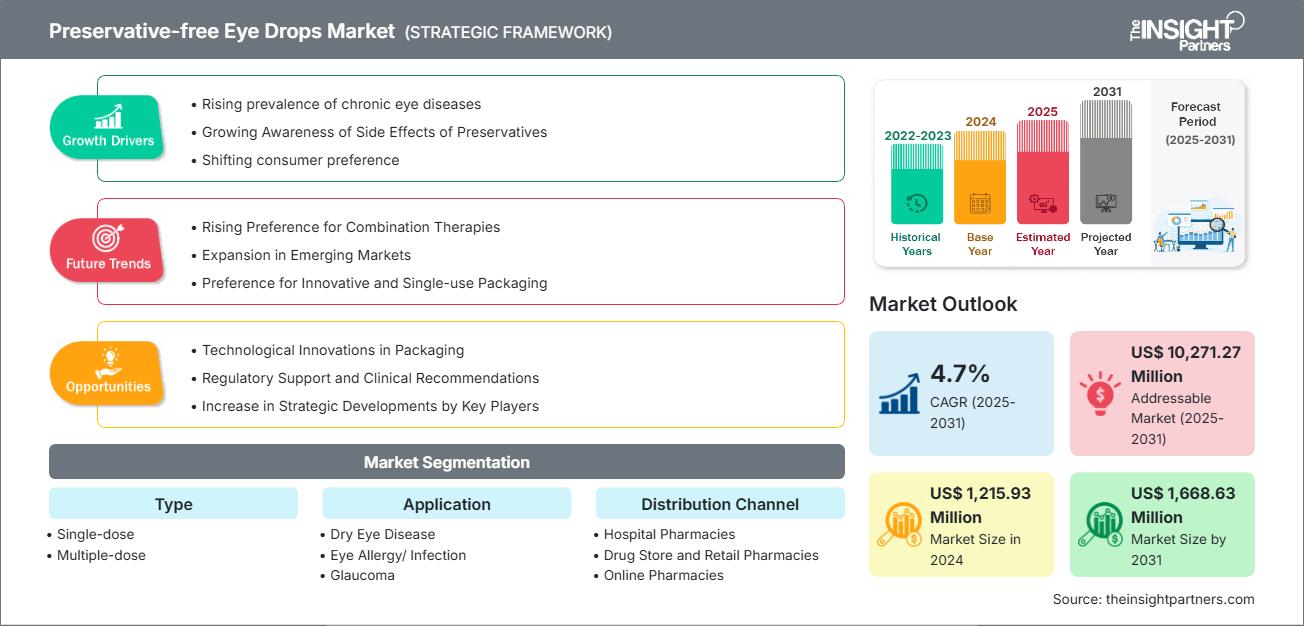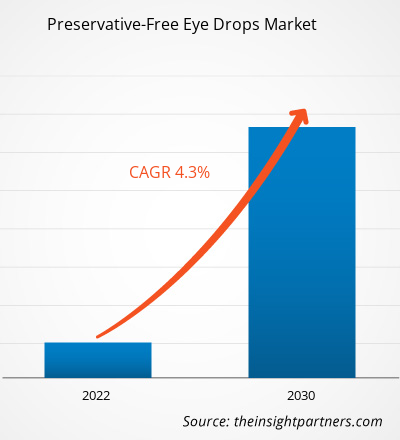Der Markt für konservierungsmittelfreie Augentropfen soll von 1,21 Milliarden US-Dollar im Jahr 2024 auf 1,63 Milliarden US-Dollar im Jahr 2031 anwachsen und im Zeitraum 2025–2031 eine durchschnittliche jährliche Wachstumsrate (CAGR) von 4,7 % verzeichnen.CAGR of 4.7% during 2025–2031.
Marktanalyse für konservierungsmittelfreie Augentropfen
Die zunehmende Verbreitung chronischer Augenerkrankungen, das wachsende Bewusstsein für die Nebenwirkungen von Konservierungsstoffen und veränderte Verbraucherpräferenzen treiben das Marktwachstum voran. Technologische Innovationen im Verpackungsbereich werden in den kommenden Jahren zahlreiche Chancen für den Markt für konservierungsmittelfreie Augentropfen schaffen.
Marktübersicht für konservierungsmittelfreie Augentropfen
Augentropfen ohne Konservierungsstoffe erfreuen sich auf dem Markt für Augenpflegeprodukte zunehmender Nachfrage. Die Menschen sind sich der Gefahren der in Augentropfen verwendeten Konservierungsstoffe zunehmend bewusst. Darüber hinaus spielt die Tatsache, dass Verbraucher chemiefreie und schonende Produkte herkömmlichen Produkten vorziehen, eine wichtige Rolle bei der Verbreitung konservierungsmittelfreier Formulierungen.
Der Markt für konservierungsmittelfreie Augentropfen in Nordamerika ist aufgrund der umfassenden Gesundheitsinfrastruktur und des Bewusstseins für die potenziellen Auswirkungen von Konservierungsstoffen in Augentropfen weltweit führend. Im Gegensatz dazu wächst der asiatisch-pazifische Raum aufgrund des verbesserten Zugangs zur Gesundheitsversorgung, der alternden Bevölkerung und steigender verfügbarer Einkommen rasant. Das Wachstumstempo in den verschiedenen Regionen hängt daher maßgeblich von der demografischen Entwicklung, der Entwicklung des Gesundheitswesens und der Patientenpräferenz für konservierungsmittelfreie Optionen ab.
Sie erhalten kostenlos Anpassungen an jedem Bericht, einschließlich Teilen dieses Berichts oder einer Analyse auf Länderebene, eines Excel-Datenpakets sowie tolle Angebote und Rabatte für Start-ups und Universitäten.
Markt für konservierungsmittelfreie Augentropfen: Strategische Einblicke

-
Holen Sie sich die wichtigsten Markttrends aus diesem Bericht.Dieses KOSTENLOSE Beispiel umfasst Datenanalysen, die von Markttrends bis hin zu Schätzungen und Prognosen reichen.
Markttreiber und Chancen für konservierungsmittelfreie Augentropfen
Markttreiber:
- Steigende Prävalenz chronischer Augenerkrankungen: Die steigende Zahl chronischer Augenerkrankungen wie dem Trockenen Auge und dem Glaukom ist der Hauptgrund für den steigenden Bedarf an konservierungsmittelfreien Augentropfen. Patienten suchen nach weniger aggressiven, langfristigen Behandlungsmöglichkeiten, die die Augenoberfläche nicht weiter schädigen.
- Wachsendes Bewusstsein für die Nebenwirkungen von Konservierungsstoffen: Aufgrund des gestiegenen Bewusstseins von Patienten und Ärzten hinsichtlich der reizenden Wirkung von Konservierungsstoffen steigt die Nachfrage nach Augentropfen ohne Konservierungsstoffe.irritative nature of preservatives, a demand for eye drops without preservatives is on the rise.
- Veränderte Verbraucherpräferenzen: Verbraucher entscheiden sich zunehmend für konservierungsmittelfreie Produkte, vor allem aufgrund von Bedenken hinsichtlich chemischer Belastung und Augenempfindlichkeit. Sie bevorzugen natürliche, sichere und reizfreie Produkte, die den ganzheitlichen und patientenorientierten Trends im Gesundheitswesen entsprechen.
Marktchancen:
- Technologische Innovationen bei der Verpackung: Neue Technologien sterilisieren und vereinfachen Produkte, wie etwa mechanische Filter und Airless-Systeme für konservierungsmittelfreie Augentropfen, und ermöglichen so sicherere Mehrfachdosisoptionen, die der Nachfrage eines sich entwickelnden Marktes gerecht werden.
- Regulatorische Unterstützung und klinische Empfehlungen: Strengere Vorschriften und positive klinische Empfehlungen machen konservierungsmittelfreie Augentropfen zur sichersten Alternative. Dadurch beschleunigt sich die Marktakzeptanz und innovative konservierungsmittelfreie Formulierungen und Verabreichungssysteme erhalten einfachere Zulassungsverfahren.
- Zunahme strategischer Entwicklungen durch wichtige Akteure: Produktinnovation, Digitalisierung von Prozessen, Einführung nachhaltiger Verpackungen und Wettbewerbsfähigkeit sind die vier Strategien, die das Marktwachstum von konservierungsmittelfreien Augentropfenportfolios vorantreiben und somit ihre Reichweite erhöhen.
Segmentierungsanalyse des Marktberichts über konservierungsmittelfreie Augentropfen
Der Markt für konservierungsmittelfreie Augentropfen ist in verschiedene Segmente unterteilt, um einen besseren Überblick über die Funktionsweise, das Wachstumspotenzial und die neuesten Trends zu geben. Nachfolgend finden Sie den Standardsegmentierungsansatz, der in den meisten Branchenberichten verwendet wird:
Nach Typ:
- Einzeldosis: Einzeldosis-Augentropfen sind konservierungsmittelfrei und für empfindliche und häufige Anwender geeignet, da sie einfach anzuwenden und frei von Verunreinigungen sind.
- Mehrfachdosis: Konservierungsmittelfreie Mehrfachdosis-Tropfen sind so konzipiert, dass sie ihre Sterilität bei längerer Haltbarkeit bewahren und einfach verwendet werden können.
Nach Anwendung:
- Trockenes Auge (DED): DED ist die Hauptursache und damit auch der Grund für den Trend zu sanften, konservierungsmittelfreien, befeuchtenden Augentropfen.
- Augenallergie/-infektion: Konservierungsmittelfreie Tropfen bieten die bestmögliche Linderung für empfindliche Augen aufgrund von Allergien oder Infektionen.
- Glaukom: Im Laufe der Zeit wird bei der Behandlung eines chronischen Glaukoms häufig auf konservierungsmittelfreie Tropfen umgestellt, um die durch Konservierungsmittel verursachten Schäden an der Augenoberfläche zu minimieren.
- Netzhauterkrankungen: Konservierungsmittelfreie Medikamente legen den Grundstein für die Augengesundheit bei Netzhauterkrankungen, die eine längerfristige lokale Therapie erfordern.
- Andere Indikationen: Zwei Patientengruppen, die sich nach Operationen oder Kontaktlinsen tragen, profitieren von den sicheren Augentropfen ohne Konservierungsstoffe.
Nach Vertriebskanal:
- Krankenhausapotheken
- Drogerie- und Einzelhandelsapotheken
- Online-Apotheken
Nach Geografie:
- Nordamerika
- Europa
- Asien-Pazifik
- Lateinamerika
- Naher Osten und Afrika
Der Markt für konservierungsmittelfreie Augentropfen in Nordamerika wird voraussichtlich einen bedeutenden Marktanteil halten. Faktoren wie die steigende Zahl chronischer Augenerkrankungen, darunter das Trockene-Augen-Syndrom und Glaukom, dürften die Marktentwicklung, insbesondere bei älteren Menschen, vorantreiben und den Markt ankurbeln.
Regionale Einblicke in den Markt für konservierungsmittelfreie Augentropfen
Die Analysten von The Insight Partners haben die regionalen Trends und Faktoren, die den Markt für konservierungsmittelfreie Augentropfen im Prognosezeitraum beeinflussen, ausführlich erläutert. In diesem Abschnitt werden auch die Marktsegmente und die geografische Lage für konservierungsmittelfreie Augentropfen in Nordamerika, Europa, im asiatisch-pazifischen Raum, im Nahen Osten und Afrika sowie in Süd- und Mittelamerika erläutert.
Umfang des Marktberichts über konservierungsmittelfreie Augentropfen
| Berichtsattribut | Details |
|---|---|
| Marktgröße im Jahr 2024 | 1,21 Milliarden US-Dollar |
| Marktgröße bis 2031 | 1,66 Milliarden US-Dollar |
| Globale CAGR (2025 – 2031) | 4,7 % |
| Historische Daten | 2021–2023 |
| Prognosezeitraum | 2025–2031 |
| Abgedeckte Segmente |
Nach Typ
|
| Abgedeckte Regionen und Länder |
Nordamerika
|
| Marktführer und wichtige Unternehmensprofile |
|
Dichte der Marktteilnehmer für konservierungsmittelfreie Augentropfen: Verständnis ihrer Auswirkungen auf die Geschäftsdynamik
Der Markt für konservierungsmittelfreie Augentropfen wächst rasant. Die steigende Nachfrage der Endverbraucher ist auf Faktoren wie veränderte Verbraucherpräferenzen, technologische Fortschritte und ein stärkeres Bewusstsein für die Produktvorteile zurückzuführen. Mit der steigenden Nachfrage erweitern Unternehmen ihr Angebot, entwickeln Innovationen, um den Bedürfnissen der Verbraucher gerecht zu werden, und nutzen neue Trends, was das Marktwachstum weiter ankurbelt.

- Erhalten Sie einen Überblick über die wichtigsten Akteure auf dem Markt für konservierungsmittelfreie Augentropfen
Konservierungsmittelfreie Augentropfen Marktanteilsanalyse nach Geografie
Der asiatisch-pazifische Raum dürfte in den nächsten Jahren das stärkste Wachstum verzeichnen. Auch die Schwellenmärkte in Süd- und Mittelamerika, dem Nahen Osten und Afrika bieten Anbietern konservierungsmittelfreier Augentropfen zahlreiche ungenutzte Expansionsmöglichkeiten.
Der Markt für konservierungsmittelfreie Augentropfen wächst in den einzelnen Regionen unterschiedlich, was auf Empfehlungen von Aufsichtsbehörden und medizinischen Richtlinien für konservierungsmittelfreie Produkte zurückzuführen ist. Nachfolgend finden Sie eine Übersicht über Marktanteile und Trends nach Regionen:
1. Nordamerika
- Marktanteil: Hält einen bedeutenden Anteil des Weltmarktes
- Wichtige Treiber: Ein technologisch fortschrittliches Gesundheitssystem, ein gesteigertes Bewusstsein für die Nebenwirkungen von Konservierungsstoffen und eine große ältere Bevölkerung unterstützen die Nachfrage nach konservierungsmittelfreien Augentropfen in Nordamerika.
- Trends: Fortschritte in der Fertigung und nachhaltige Praktiken
2. Europa
- Marktanteil: Erheblicher Anteil aufgrund der zunehmenden Verbreitung von Schmerzzuständen
- Wichtige Treiber: Zu den Hauptgründen, warum Regulierungsbehörden robuste Regulierungsrahmen für konservierungsmittelfreie Augentropfen schaffen, zählen die zunehmende Verbreitung chronischer Augenerkrankungen und die wachsende Präferenz der Patienten für konservierungsmittelfreie Lösungen.
- Trends: Regulatorischer Einfluss auf die Marktstruktur
3. Asien-Pazifik
- Marktanteil: Am schnellsten wachsende Region mit jährlich steigenden Marktanteilen
- Wichtige Treiber: Die Kombination aus einem verbesserten Zugang zur Gesundheitsversorgung, einer allmählich wachsenden älteren Bevölkerung und dem stetigen Anstieg des verfügbaren Einkommens in den Märkten der Asien-Pazifik-Region hat zu einem schnellen Wachstum konservierungsmittelfreier Augentropfen in dieser Region geführt.
- Trends: Innovationen bei Formulierungen und Verabreichung
4. Süd- und Mittelamerika
- Marktanteil: Wachsender Markt mit stetigem Fortschritt
- Hauptgründe: Die Zunahme von Augenkrankheiten und der Ausbau der Gesundheitsinfrastruktur in Süd- und Mittelamerika sind die Hauptgründe für die Einführung konservierungsmittelfreier Augentropfen in diesen Regionen.
- Trends: Technologische Entwicklungen in der Arzneimittelherstellung
5. Naher Osten und Afrika
- Marktanteil: Zwar klein, aber schnell wachsend
- Haupttreiber: Die gut ausgestattete Gesundheitsbranche und das gestiegene Bewusstsein für die Bedeutung der Augenpflege sind zwei Hauptgründe für die Nachfrage nach konservierungsmittelfreien Augentropfen im Nahen Osten und in Afrika.
- Trends: Wachstum bei therapeutischen Produkten
Dichte der Marktteilnehmer für konservierungsmittelfreie Augentropfen: Verständnis ihrer Auswirkungen auf die Geschäftsdynamik
Hohe Marktdichte und Wettbewerb
Der Wettbewerb ist aufgrund etablierter Akteure wie Alcon AG, Bausch + Lomb Corporation und Bayer AG stark. Regionale und Nischenanbieter wie Rohto Pharmaceutical Co., Ltd. und Ursapharm Arzneimittel GmbH tragen zum Wettbewerbsumfeld in verschiedenen Regionen bei.
Dieser hohe Wettbewerbsdruck zwingt Unternehmen dazu, sich durch folgende Angebote von der Masse abzuheben:
- Fortschrittliche Produkte
- Mehrwertdienste wie individuelle Anpassungen und nachhaltige Lösungen
- Wettbewerbsfähige Preismodelle
- Einhaltung regulatorischer Richtlinien
Chancen und strategische Schritte
- Unternehmen investieren mehr in Forschung und Entwicklung, was Innovationen in der Erkennungstechnologie vorantreibt. Dadurch werden auch die Sensitivität und Spezifität verbessert und spezifische Augengesundheitsprobleme in verschiedenen Regionen angesprochen.
- Die Hersteller werden sich wahrscheinlich auf die lokale Produktion konzentrieren, um Kosten zu senken und die Lieferketten zu stärken, insbesondere in Märkten mit hohem Volumen wie Indien.
Weitere im Rahmen der Recherche analysierte Unternehmen:
- Essex Bio-Technology Limited
- Pillar5 Pharma Inc.
- iVIZIA
- CorneaCare Inc.
- Stericon
- Eyecirque
- Aptar Pharma
- Ursapharm Arzneimittel GmbH
- Rohto Pharmaceutical Co., Ltd.
- Himalaya Herbals
Marktnachrichten und aktuelle Entwicklungen zu konservierungsmittelfreien Augentropfen
- Santen bringt RYJUSEA Mini-Augentropfen 0,025 % auf den Markt. Japans erste Augentropfenlösung zur Verlangsamung der Myopieprogression. Santen Pharmaceutical Co., Ltd. gab die Markteinführung von RYJUSEA Mini-Augentropfen 0,025 % (Wirkstoff: Atropinsulfathydrat, im Folgenden „Produkt“) bekannt. Das Produkt wird als nicht im nationalen Preisstandard für Krankenversicherungen aufgeführtes Arzneimittel verkauft und nicht von der gesetzlichen Krankenversicherung übernommen.
- Bausch + Lomb gibt die Veröffentlichung von Phase-3-Daten zu LUMIFY-Augentropfen gegen Rötungen ohne Konservierungsstoffe bekannt. Bausch + Lomb Corporation gab bekannt, dass Ophthalmology and Therapy Ergebnisse einer Phase-3-Studie veröffentlicht hat, in der die Wirksamkeit und Sicherheit von LUMIFY-Augentropfen gegen Rötungen ohne Konservierungsstoffe im Vergleich zu LUMIFY-Augentropfen gegen Rötungen zur Verringerung von Augenrötungen bewertet wurde.
Marktbericht zu konservierungsmittelfreien Augentropfen – Abdeckung und Ergebnisse
Der Bericht „Marktgröße und Prognose für konservierungsmittelfreie Augentropfen (2021–2031)“ bietet eine detaillierte Analyse des Marktes und deckt die folgenden Bereiche ab:
- Marktgröße und Prognose für konservierungsmittelfreie Augentropfen auf globaler, regionaler und Länderebene für alle wichtigen Marktsegmente, die im Rahmen des Berichts abgedeckt sind
- Markttrends für konservierungsmittelfreie Augentropfen sowie Marktdynamiken wie Treiber, Einschränkungen und wichtige Chancen
- Detaillierte PEST- und SWOT-Analyse
- Marktanalyse für konservierungsmittelfreie Augentropfen mit wichtigen Markttrends, globalen und regionalen Rahmenbedingungen, wichtigen Akteuren, Vorschriften und aktuellen Marktentwicklungen
- Branchenlandschaft und Wettbewerbsanalyse mit Marktkonzentration, Heatmap-Analyse, prominenten Akteuren und jüngsten Entwicklungen auf dem Markt für konservierungsmittelfreie Augentropfen
- Detaillierte Firmenprofile
- Historische Analyse (2 Jahre), Basisjahr, Prognose (7 Jahre) mit CAGR
- PEST- und SWOT-Analyse
- Marktgröße Wert/Volumen – Global, Regional, Land
- Branchen- und Wettbewerbslandschaft
- Excel-Datensatz
Aktuelle Berichte
Verwandte Berichte
Erfahrungsberichte
Grund zum Kauf
- Fundierte Entscheidungsfindung
- Marktdynamik verstehen
- Wettbewerbsanalyse
- Kundeneinblicke
- Marktprognosen
- Risikominimierung
- Strategische Planung
- Investitionsbegründung
- Identifizierung neuer Märkte
- Verbesserung von Marketingstrategien
- Steigerung der Betriebseffizienz
- Anpassung an regulatorische Trends






















 Kostenlose Probe anfordern für - Markt für konservierungsmittelfreie Augentropfen
Kostenlose Probe anfordern für - Markt für konservierungsmittelfreie Augentropfen